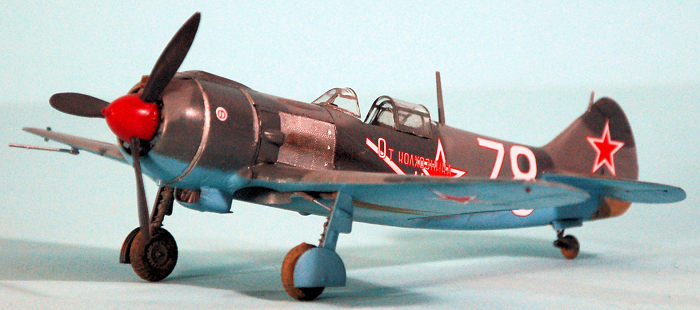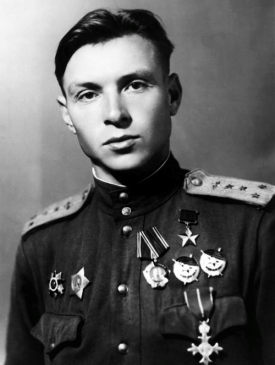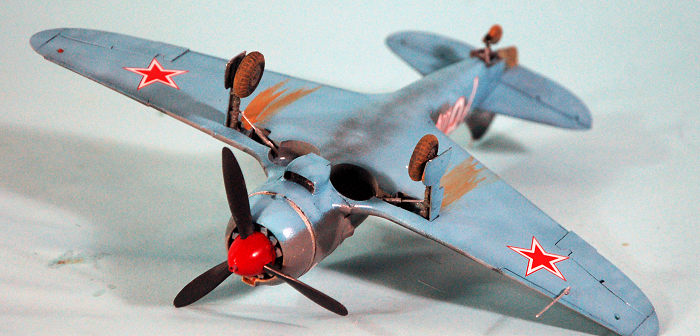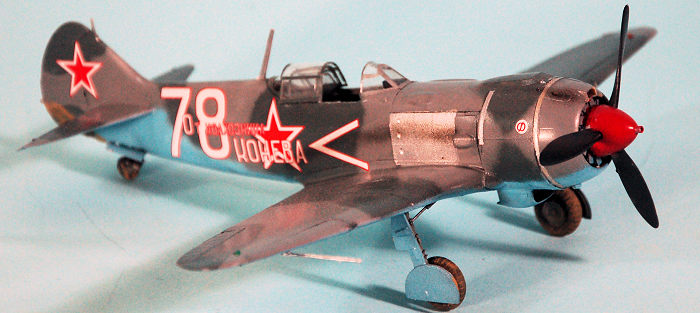
Zvezda 1/48 La-5F
| KIT #: | 4801 |
| PRICE: | $29.95 |
| DECALS: | Two options |
| REVIEWER: | Tom Cleaver |
| NOTES: | Modified to La-5F with Loon Models conversion set; AML 48-027 “Soviet Aces in Lavochkin La-5F’s Part II” used for markings. |

| HISTORY |
The Lavochkin La-5 was developed from the earlier LaGG-1 and LaGG-3 fighters, which suffered from too-heavy airframes and lack of a suitably-powerful engine. They were among the least popular fighters used by the V-VS during the Great Patriotic War and were known by a play on the aircraft designation which translated as “varnished guaranteed coffin,” which said everything one wanted to know about the deficiencies.
 By
late 1941, Stalin was commenting negatively on the LaGG-3 and the factories
previously committed to the production of the LaGG-3 were turned over to
Yakovlev for the production of the Yak-1 and Yak-7 fighters, which were
notably superior designs. Motivated by fear of being imprisoned for sabotage
by the NKVD for the failure of the LaGG-3, two of the designers - Semyon
Lavochkin and Vladimir Gorbunov - decided to make a radical attempt at
giving the fighter sufficient power, experimentally fitting a LaGG-3 with
the Shvetsov ASh-82A radial engine. The design work required to adapt the
LaGG-3 to the new engine and still maintain the aircraft's balance was
undertaken by Lavochkin in a small hut beside an airfield over the winter of
1941-1942, all completely unofficially. Ultimately, Lavochkin accomplished
his goal by grafting the nose section of a Sukhoi Su-2 to the narrow
fuselage of the LaGG-3.
By
late 1941, Stalin was commenting negatively on the LaGG-3 and the factories
previously committed to the production of the LaGG-3 were turned over to
Yakovlev for the production of the Yak-1 and Yak-7 fighters, which were
notably superior designs. Motivated by fear of being imprisoned for sabotage
by the NKVD for the failure of the LaGG-3, two of the designers - Semyon
Lavochkin and Vladimir Gorbunov - decided to make a radical attempt at
giving the fighter sufficient power, experimentally fitting a LaGG-3 with
the Shvetsov ASh-82A radial engine. The design work required to adapt the
LaGG-3 to the new engine and still maintain the aircraft's balance was
undertaken by Lavochkin in a small hut beside an airfield over the winter of
1941-1942, all completely unofficially. Ultimately, Lavochkin accomplished
his goal by grafting the nose section of a Sukhoi Su-2 to the narrow
fuselage of the LaGG-3.
When the prototype took flight in March, 1942, the results were outstanding. The fighter finally had an engine powerful enough to perform well. The LaG-5 - the designation change noting that one of the original designers was no longer involved - was declared superior to the Yak-7, by the initial test pilots. Intensive flight tests began in April, and while the design was still inferior to German fighters at altitudes over 15,000 feet, it was faster than both the Bf-109 and the Fw-190 at altitudes below 15,000 feet and was more maneuverable than either German fighter at low altitude; given that nearly all air combat on the Eastern Front took place at altitudes under 15,000 ft, the new design was very much in its element. With the additional power of the new engine, armament was upgraded to two 20mm Berezin B-20 cannon, making it the most heavily-armed Soviet fighter. With the test results so good, Stalin ordered maximum-rate production in July, 1942. Known as the La-5 after the departure of Gorbunov, production also included conversion of incomplete LaGG-3 airframes to the new design configuration.
 Before the La-5 went into production, a modified prototype had flown with a
cut-down rear fuselage and an all-round vision canopy, similar to that of
the Yak-1b. While the need was so great, the La-5 went immediately into
production using the unfinished LaGG-3 airframes. In March 1943, production
moved on to the La-5F, which featured the cut-down fuselage, with an ASh-82F
(“Forsirovanny” - boosted) engine, which had the same output but gave
improved performance at a higher altitude than the earlier Ash-82A. Top
speed was 345 mph at sea level and 370 mph at 6,500 ft.; due to airflow
limitations, the engine boost system could not be used above 6,500 ft.
Before the La-5 went into production, a modified prototype had flown with a
cut-down rear fuselage and an all-round vision canopy, similar to that of
the Yak-1b. While the need was so great, the La-5 went immediately into
production using the unfinished LaGG-3 airframes. In March 1943, production
moved on to the La-5F, which featured the cut-down fuselage, with an ASh-82F
(“Forsirovanny” - boosted) engine, which had the same output but gave
improved performance at a higher altitude than the earlier Ash-82A. Top
speed was 345 mph at sea level and 370 mph at 6,500 ft.; due to airflow
limitations, the engine boost system could not be used above 6,500 ft.
The definitive La-5FN (“Forsirovanny Neprosredstvenno” - Directly Boosted) first left the factory on March 23, 1943. It is considered a parallel development of the La-5F rather than a successor, and both continued in simultaneous production through most of the remainder of 1943. The La-5F remained in service throughout the war. 9,920 La-5s of all sub-types were produced between 1943-45. La-5 losses were the highest of all fighters in the V-VS, except the Yak-1, with total losses of 2,591 during the war.
Kyril Yevstigneyev:
 Kyril
Yevstigneyev was born into a peasant family on February 17, 1917 in the
village of Khokhly, Chelyabinsky Uyezd, Orenburg Governorate, in Russia's
trans-Urals. He attended the Shumikhin elementary school before moving on to
the Chelyabinsk industrial school where he trained as a fitter and on
graduation went to work at the Chelyabinsk Tractor Plant where he joined the
local aeroclub and got his first taste of flying.
Kyril
Yevstigneyev was born into a peasant family on February 17, 1917 in the
village of Khokhly, Chelyabinsky Uyezd, Orenburg Governorate, in Russia's
trans-Urals. He attended the Shumikhin elementary school before moving on to
the Chelyabinsk industrial school where he trained as a fitter and on
graduation went to work at the Chelyabinsk Tractor Plant where he joined the
local aeroclub and got his first taste of flying.
Yevstigneyev joined the Red Army in September 1938 with the aim of becoming a pilot. He graduated from the Bijsk military pilot academy in the far-eastern Amur region in 1941, and was posted as a flying instructor to Serashevo. At the end of 1942 he was reassigned to Moscow, where he came to the attention of I. S. Soldatenko, who arranged for a posting to the front on March 17, 1943.
Yevstigneyev gained his first victories two weeks after his arrival at the front, shooting down a Bf-109 individually with a shared victory over a Ju-88 on March 28, 1943, near the village of Urazovo in Belgorod province, southwest of Moscow. On August 5, 1943 while flying a close air-support sortie in the vicinity of Belgorod, Yestigneyev's eight-aircraft formation engaged opposing German fighters. In the ensuing dogfight he was badly wounded in both feet and sent to a field hospital where he repeatedly argued with the surgeons not to amputate his feet. After nine days, he escaped from the hospital and made his way to the nearest airfield, a 35 kilometer hike on crutches, where he was able to get transport to his unit. While still on crutches, he managed to get back into combat flying; by the end of 1943 he had flown 144 sorties during which he scored 23 individual and three shared victories.
By August 1944 he was a squadron commander in the 240th Fighter Aviation Regiment when he was first awarded the Hero of the Soviet Union on August 2. He was awarded the British OBE in 1943, and a second HSU on February 23, 1945, by which time he was promoted to captain and made a squadron commander in 178th Guards Fighter Aviation Regiment. Yevstigneyev scored his 53rd and last aerial victory on March 26, 1945, a Fw-190 shot down over Budapest. By May 1945 he had been promoted to Major. Between March 1943 and April 1945 he flew 283 combat missions, engaged in 119 dogfights, and scored 53 solo and three shared aerial victories.
Kyril Yevstigneyev remained in the Red Air Force after the war. In 1966, he was promoted to Major General of Aviation, before retiring in 1972. He died in Moscow in 1996.
| THE KIT |
 Prior
to the release of Zvezda’s La-5 and La-5FN kits in 2004, the only accurate
kit of this airplane was a vacuform released by Falcon Models in 1984.
During the 1990s, Hobbycraft released an La-5 which could at best be
described as “La-5-ish,” since it attempted to mishmash the varying detail
differences of the La-5FN and La-7 into a single kit. The quality of
Zvezda’s kits is such they were named “Kit of the Year” in Russia.
Prior
to the release of Zvezda’s La-5 and La-5FN kits in 2004, the only accurate
kit of this airplane was a vacuform released by Falcon Models in 1984.
During the 1990s, Hobbycraft released an La-5 which could at best be
described as “La-5-ish,” since it attempted to mishmash the varying detail
differences of the La-5FN and La-7 into a single kit. The quality of
Zvezda’s kits is such they were named “Kit of the Year” in Russia.
The kit has complete internal detail, a detailed engine and 20mm cannons. All of this is out of sight if the model is assembled “buttoned up,” but it is an excellent candidate for a diorama of one being serviced. Parts fit is excellent throughout and two rear clear glass parts are provided so the sliding canopy can be mounted either open or closed.
| CONSTRUCTION |
The
only particularly fiddly part of construction is the wing sub-assembly.
There is a one-piece lower wing half, which insures proper dihedral. For
some strange reason, the upper wing halves are sub-divided between inner and
outer wing parts. In order to obtain proper alignment, it’s a good idea to
assemble the upper wing parts together before attaching the upper wing parts
to the lower wing. If you attach the upper wing part by the wheel well to
the lower part of the wheel
 well in the lower wing first, you will have no
trouble aligning the upper wing part to the lower wing. The leading edge
slats, which are provided separately, were wired shut on the La-5, so attach
them to the wing in he closed position. The ailerons are separate and can be
attached slightly articulated if you wish. The elevators and rudder are also
separate and can be posed in more dynamic positions.
well in the lower wing first, you will have no
trouble aligning the upper wing part to the lower wing. The leading edge
slats, which are provided separately, were wired shut on the La-5, so attach
them to the wing in he closed position. The ailerons are separate and can be
attached slightly articulated if you wish. The elevators and rudder are also
separate and can be posed in more dynamic positions.
The fuselage interior is not particularly fiddly, but it’s a good idea to take your time. It’s helpful to attach the interior structure to the wing sub-assembly to get proper alignment, then attach the fuselage halves on at a time. Take care in fitting the parts and you won’t need any filler.
The engine is really nice, but with the cowling closed up and the fan from the prop in position, it’s as visible as the engine on an Fw-190A - in other words, invisible. But you need to assemble and attach it regardless of whether the cowl is open or closed, in order to mount the prop.
The Loon Models resin conversion is mostly the parts from the earlier La-5 kit, which are substituted for the similar parts from the La-5FN kit. Clean up the parts and the fit is perfect without any problems and no filler required.
| COLORS & MARKINGS |
There are several companies that produce paints matched to the Red Air Force colors. I mixed up the light blue, light grey and dark grey colors from Tamiya paints, as detailed at the Modeling the V-VS page on the internet. Before applying the camouflage, I painted the natural metal panel aft of the engine exhaust and the tightening strips on the cowling, then masked them off.
I pre-shaded the model, then applied the lower color, followed by the lighter grey on the upper surfaces and then the dark grey, all applied freehand following the paint diagram on the decal instructions. When finished, I gave the model a coat of clear gloss varnish.
 I used the
AML 48-027 “Soviet Aces in Lavochkin La-5F’s Part II” decal sheet, which I
bought from Scott’s Model Shop - “rebelalpha” on eBay. In case you’re
interested, Scott Zuiebank has what I have to say is the widest selection of
difficult-to-find decals available. I could spend all day going through the
decal sheet boxes there in the shop (it’s 2 miles from where I live, so I don’t
do mail order). Your time would be well spent going through the shop’s catalog
on eBay if you want to find markings that haven’t been “done to death” for air
forces and units not considered “mainstream.” These AML decals were well-printed
and opaque, and went on without problem under an application of Micro-Sol.
I used the
AML 48-027 “Soviet Aces in Lavochkin La-5F’s Part II” decal sheet, which I
bought from Scott’s Model Shop - “rebelalpha” on eBay. In case you’re
interested, Scott Zuiebank has what I have to say is the widest selection of
difficult-to-find decals available. I could spend all day going through the
decal sheet boxes there in the shop (it’s 2 miles from where I live, so I don’t
do mail order). Your time would be well spent going through the shop’s catalog
on eBay if you want to find markings that haven’t been “done to death” for air
forces and units not considered “mainstream.” These AML decals were well-printed
and opaque, and went on without problem under an application of Micro-Sol.
I washed the decal solvent residue off the model and gave it a coat of Satin Clear, since Soviet fighters were covered with a thick coat of wax polish at the factory. I then unmasked the natural metal areas and the canopy. I installed the sliding canopy section in the open position. I finished by attaching the landing gear and prop, then applying exhaust staining with Tamiya “Smoke.”
| CONCLUSIONS |
The La-5 series are my favorite Soviet fighters of the Great Patriotic War (perhaps the fact they resemble Fw-190s, my favorite German fighter, has something to do with it?). The Zvezda kit is a really superb starting place for making a really nice model of these famous fighters. With this conversion, I now have all three sub-types in my collection (along with a LaGG-3 from ICM). The Loon Models conversion can be found online if you look around. The Zvezda kits won’t present problems to a mid-level modeler and can be a real show-stopper for an advanced modeler to detail. Highly recommended.
Back to the Main Page Back to the Previews Index Page
Back to the Previews Index Page